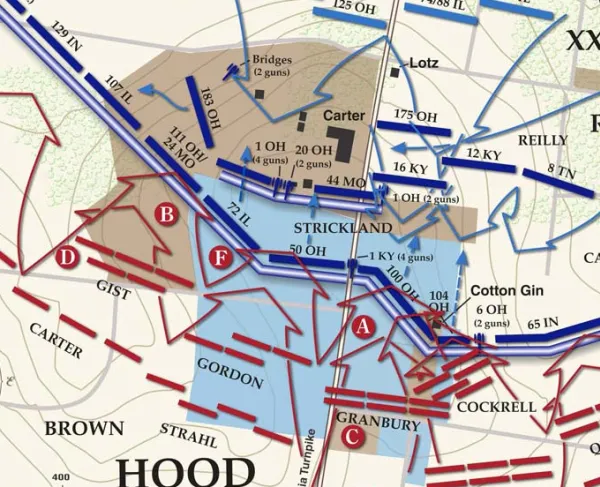
Franklin Battlefield, Tenn.
American Battlefield Trust Preserves Two Properties on the Franklin Battlefield
A crucial one and a half acres across two properties on the Franklin Battlefield have been saved forever. In recent years, Franklin has evolved to be a major suburb of Nashville, driving up prices and making each acre saved even more precious.
The two properties saved are adjacent to land already preserved by the Trust, adding to the nearly 200 acres saved by the Trust and its partners on the battlefield and telling a more complete story of the battle. As with other expensive Franklin projects, this work would not have been possible without the availability of matching grants from the federal American Battlefield Protection Program and the Tennessee Civil War Sites Preservation Fund (TCWSPF), administered by the Tennessee Wars Commission, a division of the Tennessee Historical Commission, State Historic Preservation Office, as well as support from local preservation groups and local government investment.

Franklin was once considered to be among the most threatened Civil War battlefields in America, but incredible preservation efforts in recent decades have saved and restored a significant portion of the battlefield. Thanks to your support, this land will be acquired by Franklin’s Charge to be interpreted for generations to come.
The History
On November 30, 1864, Confederate Gen. John Bell Hood, determined to defeat Union Maj. Gen. John M. Schofield’s Army of the Ohio before they could reach Union reinforcements Nashville, launched a massive frontal assault of around 20,000 men across open ground in Franklin.

From late afternoon into dusk, Confederate troops stormed the Union breastworks but were met with devastating artillery and musket fire. The attack resulted in more than 8,500 casualties, nearly 75 percent of them Confederate. The six Southern generals killed, with many more wounded or captured, made it greatest loss of such senior officers in any Civil War battle. As the fighting slowed, Schofield was able to withdraw and reach Nashville, setting the stage for Hood’s final defeat at the subsequent Battle of Nashville, effectively ending the war in Tennessee.

Both tracts on land saved are located just a few hundred feet south of the historic Carter House in Franklin and saw heavy casualties during the fighting. Scores of Confederate soldiers were killed or wounded on the property, and dozens of soldiers were buried there, before being exhumed and moved to the McGavock Confederate Cemetery.


